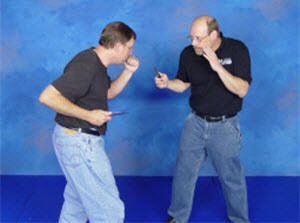 The Filipino martial arts have a long tradition of edged-weapon training. In fact, when it comes to skill with small knives, the fighting arts of the Philippines are widely regarded as some of the deadliest and most effective systems ever devised. Despite their effectiveness, these arts do not necessarily reflect the culture and legal systems of most Western societies. In their pure forms, they are therefore not the perfect solution to modern self-defense needs.
The Filipino martial arts have a long tradition of edged-weapon training. In fact, when it comes to skill with small knives, the fighting arts of the Philippines are widely regarded as some of the deadliest and most effective systems ever devised. Despite their effectiveness, these arts do not necessarily reflect the culture and legal systems of most Western societies. In their pure forms, they are therefore not the perfect solution to modern self-defense needs.
My personal interest in the Filipino martial arts began while I was learning empty-hand techniques against knives during the study of another martial art. Frustrated with the ineffectiveness of that art’s contrived knife defenses, I complained to my instructor. He offered a bit of advice that I have never forgotten: If you want to learn how to defend against a weapon, first learn how to use that weapon.
Those simple words of wisdom inspired my research into various traditional and non-traditional methods of knife fighting and ultimately led me to the formal study of Serrada Eskrima and a number of other Filipino martial arts. Unfortunately I found that, at least at the time, few instructors were willing to teach much knife technique and restricted their instruction to the stick and empty-hand aspects of the art. Nevertheless, I was determined to learn defensive knife use and began to extrapolate knife tactics from the techniques they were willing to teach. Through this analysis, I developed a straightforward, very effective system of defensive knife use.
As my training in the Filipino arts progressed, I had the opportunity to compare and contrast various styles of eskrima, arnis, and kali. I also had the rare privilege of befriending and training with some of the true modern masters of knife craft, including Master at Arms James Keating. Through these influences and literally hundreds of hours of analysis and experimentation with my private students, I refined and expanded my system of knife fighting into what I believe to be one of the most comprehensive yet easily learned programs in existence today: Martial Blade Concepts, or MBC.
The most important element of MBC is the logic behind it. Like any other potential “solution,” its value is based on its relevance to the problem it is intended to address. And that relevance can be comprehended only through an in-depth understanding of the problem we face: the defense of your life and the lives of your loved ones against the types of attacks that occur in today’s world, using the tools you can actually carry on a regular basis.
With this guiding principle in mind, let’s take a look at the logic of MBC and what I feel is really needed if you want to be prepared to defend yourself with a knife.
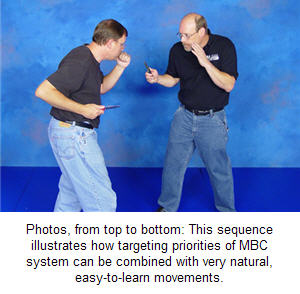
Step 1: Accept the fact that you will fight with the knife (or knives) you actually have with you when the attack happens.
Many knife “experts” have pontificated on the requirements for the ideal fighting knife, waxing eloquent about blade lengths, crossguards, handle materials, etc. That’s great, but unfortunately the fighting knives they typically recommend cannot be legally or practically carried by the average civilian on a daily basis. Let’s face it: the best fighting knife in the world is the one you have with you when the fight starts, not the one back home in your sock drawer. Understand this, accept it, and choose your weapon and your training accordingly.
Research the laws in your area and the areas you typically travel and choose a high-quality knife that is both legal in those jurisdictions and a very potent defensive weapon. If possible, choose a knife that also has a training version that is mechanically identical to your live blade, but allows safe contact training with a partner.
Then, tune your training to focus on the deployment and practical application of that weapon and make its carry part of your daily lifestyle.

Step 2: Understand and validate the cutting and puncturing performance of your actual carry knife.
Once you have decided what knife you will carry, you need to have a clear understanding of what you can do with it. And the only way to do that is to cut and puncture things with it.
By “things,” what I mean are reasonable facsimiles of flesh-and-bone body parts covered with a layer of clothing. My traditional testing target is a “pork man.” No, he is not one of the lesser-known superheroes, but a realistic cutting target made from a pork roast. To construct one, take a five-pound pork roast, butterfly it (cut it lengthwise about halfway through its thickness), and tie it around a one-inch dowel with butcher twine. Then wrap the entire thing in about half a roll of kitchen plastic wrap, tape down the ends, and cover it with the leg of a pair of jeans. The resulting target is typically a very good facsimile of the average man’s forearm, bicep/triceps, or lower thigh.
Needless to say, before you attempt any live-blade cutting tests, you need to have a degree of skill with your knife. You must also go slowly and take extreme care to avoid injury. I recommend working with an unsharpened training knife first and progressing to the live blade only when you’re sure you’re ready.
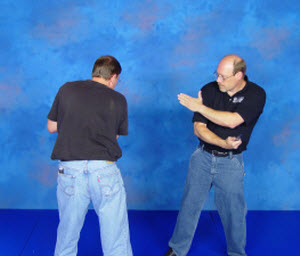
When you do move on to the live-blade tests, start out easy and let the blade do the cutting. Don’t be in a hurry and take the time to really assess the results of each cut. After you’ve done a few light cuts, add more body mechanics to the motion and see the difference in the effects on the target. Then, do the same thing with thrusting. The goal is to develop an understanding of the force you’re applying and the results you’re getting on the target, so you can relate those to a human attacker.
As you gain more experience and confidence, replace the layer of denim with other types of clothing that are consistent with the seasons and climate where you live. This will help you further understand what your knife can and can’t do and what type of protection—if any—different materials offer. This is also useful information when choosing your wardrobe.
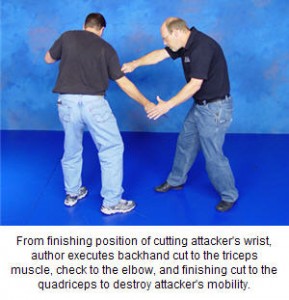
Step 3: Embrace the idea that the real goal of self-defense is to STOP your attacker.
In combat shooting circles, “stopping power” is the ability of a particular cartridge or bullet configuration to reliably cause an attacker to cease his attack. Related discussions of the topic also address targeting and bullet placement, but the bottom line is that your goal is to reliably and predictably render the bad guy incapable of harming you. Killing and stopping are not the same thing. If you inflict a mortal wound on your attacker, but it takes him several minutes to expire, he has plenty of time (not to mention motivation) to continue his attack on you.
When it comes to knife tactics, your goal is exactly the same. You must stop your attacker through a reliable physiological means, in order to keep yourself safe and create an opportunity for escape. To do this, you must understand how knives stop people and be able to separate medical fact from conjecture and hype. Again, accept that your goal is to stop your attacker and that stopping and killing are two different things.
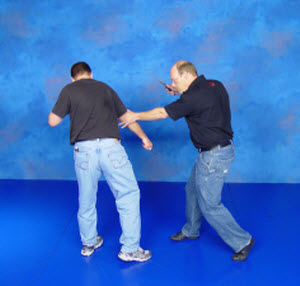
Step 4: Study human anatomy and learn what targets you can cut to reliably stop an attacker.
This is perhaps the most difficult aspect of understanding knife tactics because—to put it bluntly—the topic is clouded with misinformation, hype, and bullshit. Rather than going to martial artists, Internet forums, or even military close-combat materials (like the widely touted but wildly inaccurate W.E. Fairbairn “Timetable of Death”), pick up a copy of Gray’s Anatomy and start talking to ER doctors, paramedics, physical therapists, and actual medical professionals who see the results of knife wounds (and similar injuries that could potentially be inflicted with a knife) and ask them what stops people and what doesn’t.
As you develop an understanding of anatomy and the vulnerabilities of various body parts, relate that knowledge back to your cutting tests. Study the cross-sectional diagrams of body parts in anatomy reference books and correlate those to the depths of the cuts and punctures you achieved on your practice target. To get an idea of actual target depths, measure the corresponding part on your body and use a photocopier to enlarge the diagram in the book to full scale. Better yet, do this same thing on one of your well-fed friends (the big kind that you would really fear if he attacked you) and look at how body size affects target depth.
A thrust to the abdomen with a three-inch blade will do different damage to a 140-pound marathon runner with six-pack abs than it will to a 300-pound biker with a pony keg. By combining your empirical cutting tests with analysis of target depths on various body sizes, you will get an idea of what targets your knife can realistically reach in a fight. This knowledge should have a significant bearing on the knife tactics you choose.
Studying anatomy books and taking measurements not high-speed enough for you? Well, it’s your life to risk.
Step 5: Base your tactics on natural, easily learned movements that take into account human instincts and the natural effects of life-threatening stress.
Good knife tactics should be consistent with your natural reactions to life-threatening stress. In simple terms, the stress of a real attack will provoke a startle response (you crouch, your hands come up, your head tries to turtle into your body, and you typically square off with whatever is trying to kill you) and cause gross motor skills to override fine and complex motor skills. In even simpler terms, think caveman instead of ballet dancer.
Although it is possible to train to overcome or at least mitigate instinctive reactions to stress so you can apply complicated tactics, this takes lots of time and very intense training that replicates the stress of real attacks. The average person (and most intelligent above-average people) will instead accept the fact that they will respond instinctively and therefore build their tactics on the foundation of that instinct.
In the realm of knife tactics, this means that simple, straightforward tactics that rely on gross motor movements are your best bet. If you can’t grasp the basic mechanics of a technique within a few tries, it’s probably not going to work well for you under stress. Also, you need to bear in mind that simple things are easier to remember and easier to program as reflex. If you’re not going to train regularly but still want to have some basic knife tactics in your arsenal, keep them simple.
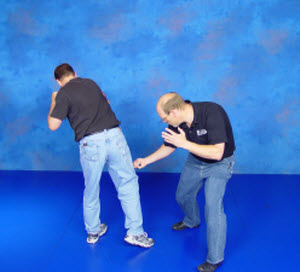
Step 6: Train and refine your skills through repetitive, scalable drills that simulate adrenal stress.
Repetition is the mother of all skill. Repetition that occurs under circumstances that simulate life-threatening stress develops skills that will actually work against a real attack. Your goal in training should therefore be to focus on drills that provide high numbers of repetitions of critical skills and do so with scalable intensity that allows you and your training partner to challenge each other. By generating a high degree of physical and psychological intensity and practicing your skills in that state, you will develop a much higher level of skill that you can rely on in a critical situation.
Half-hearted, slow-motion repetitions against a lackadaisical partner won’t cut it.
The logic outlined above forms the basis of the philosophy and training methodology of Martial Blade Concepts. Most of the inspiration and technical foundation came from the Filipino and Indonesian martial arts—arts with highly evolved knife tactics that have been proven countless times over centuries of practical application. However, as the system evolved, I changed the tactics to make them more applicable to the weapons we actually carry and the personal-defense challenges we face in our society.
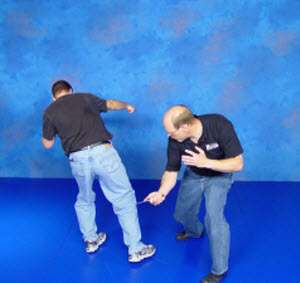 One of the foundational elements of the Filipino arts is the concept of “defanging the snake,” or biomechanical cutting. Basic anatomy teaches that muscles pull on tendons (which are like cables) to move bones. If the tendon is severed or the muscle cut deeply enough, the structure that enables movement is immediately destroyed.
One of the foundational elements of the Filipino arts is the concept of “defanging the snake,” or biomechanical cutting. Basic anatomy teaches that muscles pull on tendons (which are like cables) to move bones. If the tendon is severed or the muscle cut deeply enough, the structure that enables movement is immediately destroyed.
Traditional “defanging” with a knife typically involves cutting the flexor tendons and/or muscles on the inside of the forearm to destroy the attacker’s ability to grip his weapon. It is then followed by lethal-force thrusts to the abdomen that are usually delivered against a small-framed attacker with a reasonably large blade. However, since MBC focuses on the use of small, legal, practical knives—like folders—it takes the concept of biomechanical cutting to a higher level to achieve even better stopping results.
- MBC expands the strategy of biomechanical cutting to three primary target areas:
- The forearm and flexor tendons to destroy the grip.
- The bicep and triceps to destroy coordination motion of the weapon arm.
- The quadriceps above the knee to destroy the attacker’s mobility and allow you to create distance and seek escape.
- As suggested previously, a three-inch blade may not have an immediate disabling effect when applied against a large attacker’s torso. However, that same blade can have tremendous effect on the limbs of just about any size attacker. Based on cutting tests and empirical research of actual knife wounds, cutting any of the targets described above to the bone with a three-inch blade can be accomplished very easily and with a minimum of training. And since you are directly attacking the sources of the threat—the attacker’s grip, his ability to wield the weapon, and his mobility to deliver the weapon to you—you solve your problem much more efficiently and quickly.
The tactics used to do this—the core movements of the MBC system—are based on natural, easily learned patterns of motion that emphasize simplicity and commonality of technique. Rather than learning many specific responses for individual attacks, MBC students focus on a small number of very versatile techniques that can be reflexively applied to a broad range of situations. These techniques can also be deconstructed to modify, skip, or repeat specific actions to adapt to the dynamics of the situation.
Once these movements are learned in the context of defensive applications, they are chained together into repetitive patterns adapted from the “flow drills” of the traditional Filipino arts. These drills allow you and a partner to very efficiently practice the core movements of the system in a dynamic, flowing format.
As you progress, you can increase the intensity and speed of this practice to challenge your skills and even modify the drill or transition from one drill to another to promote spontaneous reflexes. This scalable training method provides both the repetition and the stress inoculation you need to have skills that will hold up in a real self-defense situation.
By following this logic and integrating all these elements, MBC provides a true system of tactics that promotes rapid, reflexive decision making followed by the application of natural, instinctive technique. That technique is designed to optimize the efficiency of convenient, legal-to-carry knives to quickly and effectively disable your attacker.
Personal defense is serious business that requires serious thought. Whatever knife system you choose, make sure that its logic supports your defensive needs.
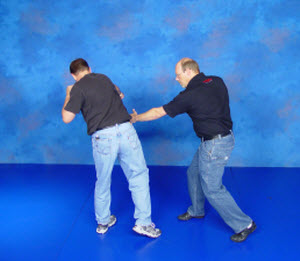
I love the methodology behind this post. It turned me into a subscriber, and puts going Premium on my to-do list. This is exactly the way I think of fighting (don't expect it to end the fight, but try to stop their body from working). And that is probably partly because of other things I have heard from you in the past, and not only because of our shared FMA background. Thank you for sharing your research with us.